With its growing economy and diverse population, Hong Kong provides the perfect environment for cultural diversity. Hong Kong citizens have incorporated many of the different into their daily lives. Throughout the city, there are evidences of cultural diversity especially in the language spoken and the signs.
In Hong Kong, the majority of the population speaks Cantonese followed by English and Mandarin Chinese. The signs around the city also exemplified this as many of the signs have English translation below the Chinese characters. For example, in the public service announcement sign below in image 1, there are Chinese and English translation on it. Being able to read some Chinese, I saw that the translation between the Chinese and English was very accurate with little discrepancy in the meaning. Additionally, in the article, it quoted Landry and Bourhis that “Having one’s own language enshrined on most private and government signs should contribute to the feeling that the in-group language has value and status relative to other languages in the sociolinguistic setting” (Leeman 334). This can be seen all around the signs in the MTR station, supporting a multilingual community. Also, the Chinese characters are displayed above the English translation, showing that although Hong Kong values both Chinese and English, Chinese is valued greater.
Another example of the cultural makeup in Hong Kong is the difference in restaurant ads in different parts of the city. For example, in the more modernized parts of the city, many of the restaurant names, including the menu would have Chinese and English. This is shown in image 2 and 3. However, in the traditional part of the city, the restaurant names might only have Chinese names, shown in image 4. The menus taped outside the restaurant would also be in Chinese unless you request for an English one. The restaurant also resembles the earlier establishment discussed in the article with its use of Chinese, and red and gold in its signage (Leeman 350). In the article, it stated that English is typically used to signify modernity and it can be applied to this situation (Leeman 335). The restaurants that accommodate both English and Chinese were from high-end restaurants, typically in nice part of the city. The restaurants that have only Chinese were typically “street shops,” that serves mainly the locals. This contrast showed that the different culture that Hong Kong supports: the modern world and the traditional world.
Despite Hong Kong using the same writing system as China, it has also incorporated some English words implicitly into its system. In the restaurant ad below shown in image 5, the word strawberry is an example of this. In Mandarin, the word for strawberry is “草莓” (Cǎo méi), so typically it should have been the same writing with a Cantonese pronunciation. However, in the restaurant ad, the word for strawberry is “士多啤梨” (si6 do1 be1 lei4), which is a translation of the English pronunciation for strawberry. This shows that Hong Kong holds English to high regards with Cantonese. This was rather not surprising to me as the two primary languages in Hong Kong prior to the 1997 Handover was Cantonese and English. Also, similar to image 1, the English translation is below the Chinese, indicating that Chinese is valued more. One interesting that I found from this ad was that the English translation of the Chinese were not so accurate. For example, the translation of “冰川甜酸橙花骨” is Glacier Sweet Sour Flower Bone, but they had to adjust the translation to make it sound more appetizing. This shows that Hong Kong put in effort to incorporate English in its culture.
Overall, being able to tour Hong Kong has been a rewarding experience. I was able to see the different incorporation of American culture into Hong Kong culture through the use of language, food, and style of dress. Most of the signs will have English translation to support the multilingual community. Through my experience, I have noticed that whether the sign is public or private, both contains Chinese and English translation. I think this is because English have been integrated deeply in Hong Kong culture.
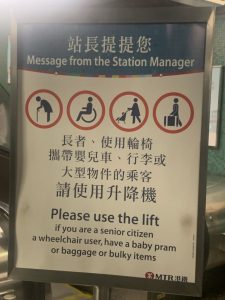
Image #1: Public Service Announcement
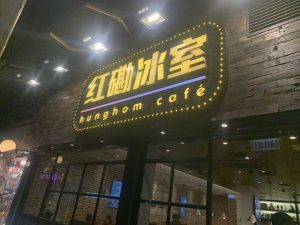
Image #2: Restaurant with Chinese and English
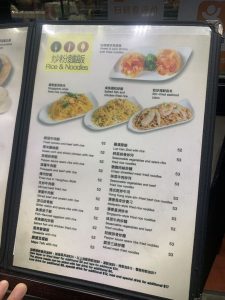
Image #3: Menu
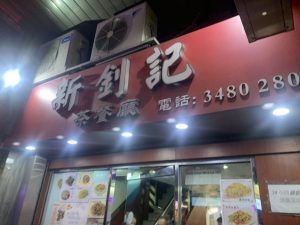
Image #4: Restaurant with only Chinese
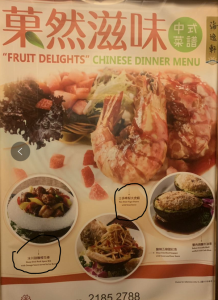
Image #5: Restaurant Ad
Steven, I found your discussion of the role of language within the resturant-industry to be rather interesting. I liked the point that you made about the ‘modernity’ of the English language, which was a nice connection to the text. I also believe that English and Chinese are two of the most ‘global’ languages at the moment in that buiseness, communication, and sicence are primarily done through these langauges.
Steven, I found your discussion of the role of language within the restaurant-industry to be rather interesting. I liked the point that you made about the ‘modernity’ of the English language, which was a nice connection to the text. I also believe that English is probably the most ‘global’ language at the moment in that is the primary mechanism through which business, communication, and science are done. One question I had was whether you thought that it’s a good business decision to leave English off of these menus at ‘traditional’ restaurants. Do you believe they’re sacrificing profits or customers by neglecting one of the world’s most popular languages?
Hey Sam thanks for reading my post!!! I would agree that English is the most “global” language since you can basically go anywhere with only using English. Your question was actually very thought-provoking as I do believe that the traditional restaurants might suffer from reduction in profits. Despite that, I think by using only Chinese, the restaurants convey a greater sense of authenticity, which will provoke the interest of tourists.
I love the way you discuss linguistic phenomena by analyzing signs and menus in details. Although I’m quite familiar with Hong Kong, it is still very interesting and refreshing to read your ideas on the different use of Mandarin, English and Cantonese. My question is about the relationship between Mandarin/simplified Chinese and Cantonese/traditional Chinese. How are they used in public/business/schools and at home? Does it appear to be regional or have certain patterns?
Hey Sarah thank you for reading my post!!! Your question actually made me evaluate my experience in Hong Kong. From my experience, I would say that Cantonese/traditional Chinese is used more regularly than Mandarin/simplified Chinese. For example, the government and public signs in Hong Kong use traditional more often in addition to official documents. Simplified Chinese is actually quite uncommon in HK even on restaurant menus. For the home environment, I’m not sure since I’ve been living in a hotel so I’ll have to ask my colleagues, sorry. I would say that the traditional Chinese have regional appeal since many regions of HK have more incorporation of traditional over simplified.
Hi Steven. It is very interesting to see that you separate Hong Kong into traditional world and the modern world. Hong Kong is one of my travel lists so I am appreciate that your essay help with my future travelling plan.
I also heard that English is weighted much more than Mandarin in Hong Kong. Do you think it is true?
Hey George thanks for reading!!! I would agree in saying that English is weighted much more than Mandarin in HK. This is because HK was in Britain’s control up until 1997 so many of HK’s culture incorporated British culture as well as its language. When HK was returned to China in 1997, HK started to incorporate Mandarin in its educational system so typically the younger generations would know how to speak Mandarin. The older generations would only know how to speak only English and Cantonese. Thus because of this, English has a greater presence than Mandarin in HK.